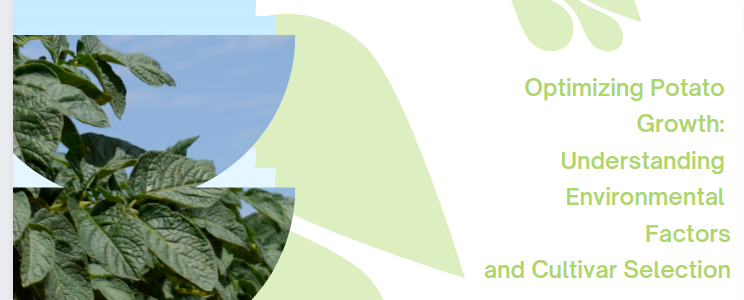#PotatoGrowthRequirements #ClimateSuitability #VarietalSelection #TemperatureEffects #HarvestConditions
Potato Growth Requirements
Environment
Potatoes are versatile crops that can be grown in a wide range of climates. However, not all environments are conducive to efficient potato production. While cool temperate to arid climates are suitable, humid sub-tropical and tropical climates pose challenges. The ideal potato growth conditions include sunny warm days with cool night temperatures, as this combination supports high yields. Cool nights aid in plant recovery and reduce unproductive energy consumption. It is crucial to seek advice on suitable potato varieties for specific environments and evaluate their adaptability before planting. In some cases, agronomic practices can compensate for varietal shortcomings, but they may increase production costs.
Potatoes originated in the cool climate of the Andean highlands in South America. Adapted varieties can maintain productivity even in semi-arid regions, as long as water and nutrient requirements are met. However, high temperatures, low humidity, or windy conditions hinder the potato plant’s ability to extract sufficient water, resulting in reduced productivity. Under prolonged water deficit, the plant’s health suffers, leading to premature vine decline and diminished productivity.
In Australia, most potato production regions offer long growing periods, allowing for year-round potato supply for the fresh market and crisping. This has led to the cultivation of potatoes outside the optimum window, requiring varieties with shorter growing seasons and adaptability to non-optimal seasonal conditions. Additional management practices, such as frost protection, ensuring adequate tuber numbers, and preparing for ground storage, are necessary to safeguard these crops.
Temperature
Temperature plays a crucial role in potato growth and development. Varieties exhibit different responses to temperature, emphasizing the importance of evaluating new varieties for specific regions and seasons. Optimal growth conditions depend on various factors, including humidity, day/night temperature variations, light intensity, day length, soil characteristics, irrigation patterns, and variety.
Key temperature-related considerations include:
Planting and emergence: Soil temperatures between 7°C and 20°C favor sprout growth, with slower growth below 7°C and increased heat damage risk above 20°C. Rhizoctonia canker risk increases below 12°C, while seed piece breakdown risk rises above 16°C.
Growth of the above-ground plant: Air temperatures between 7°C and 25°C promote growth, but excessive heat can cause plant shutdown and heat stress, with the critical temperature varying based on environmental conditions, plant health, and varietal tolerance.
Root growth: Soil temperature influences root growth, with an increase from 7°C to 28°C stimulating growth, followed by a decline at higher temperatures.
Tuber initiation: Daytime temperatures in the 15°C to 20°C range, combined with cool nights, favor tuber initiation, although it can occur outside these conditions. Variety plays a role in tuber initiation and set capacity.
Tuber bulking: Soil temperatures within the optimal range of 15°C to 20°C support tuber bulking, but the specific range may vary between varieties. Cool night-time air temperatures universally favor tuber growth.
Understanding the preferred temperature ranges for each cultivar, evaluating new varieties for local growing conditions, and assessing varietal tolerance under specific potato cultivation practices are essential considerations.
Apart from growing conditions, temperature conditions at harvest also impact potato quality. Ideally, harvesting should occur when tubers are within the temperature range of 10°C to 16°C. However, limitations in some regions may restrict opportunities for optimal harvest conditions. Under non-optimal conditions, extra attention should be given to bruise and disease management. Harvesting at night and removing field heat from tubers before storage are recommended practices.
By optimizing environmental factors, selecting suitable varieties, and managing temperature effects during cultivation and harvest, potato growers can enhance productivity and quality.
Source: Australian Potato Growing Guide








